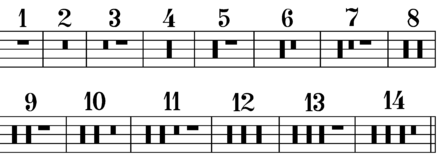Tacet
Tacet is Latin which translates literally into English as "(it) is silent" (pronounced: /ˈteɪsɪt/, /ˈtæsɪt/, or /ˈtɑːkɛt/).[1] It is a musical term to indicate that an instrument or voice does not sound, also known as a rest. In vocal polyphony and in orchestral scores, it usually indicates a long period of time, typically an entire movement. In more modern music such as jazz, tacet tends to mark considerably shorter breaks. Multirests, or multiple-measure rests, are rests which last multiple measures (or multiple rests, each of which lasts an entire measure).

Tacet. (Lat.) A word by which the performer is to understand that the instrument with the name of which it is conjoined is to be silent: a Violino Tacet; the violin is not to play: Oboe Tacet; the oboe is silent.
| Look up tacet in Wiktionary, the free dictionary. |
It was common for early symphonies to leave out the brass or percussion in certain movements, especially in slow (second) movements, and this is the instruction given in the parts for the player to wait until the end of the movement.

It is also commonly used in accompaniment music to indicate that the instrument does not play on a certain run through a portion of the music, e.g. "Tacet 1st time." The phrase tacet al fine is used to indicate that the performer should remain silent for the remainder of the piece (or portion thereof), and need not, for example, count rests.
Tacet may be appropriate when a particular instrument/voice/section, "is to rest for an entire section, movement, or composition."[3] "Partial rests, of course, in every case must be written in. Even though it means 'silent,' the term tacet...is not a wise substitution for a lengthy rest within a movement...The term tacet, therefore, should be used only to indicate that a player rests throughout an entire movement. In printed music this would be indicated:"[4]
"N.C." ("no chord"[5][6][7][8]) is often used in guitar tablature or chord charts to indicate tacets, rests, or caesuras in the accompaniment.
Uses of tacet
The earliest known usage of the term is 1724.[1]
A unique usage of this term is in John Cage's 1952 composition 4′33″. A tacet is indicated for all three movements, for all instruments. The piece's first performance lasted a total of 4 minutes and 33 seconds, without a note being played.
See also
References
- "Tacet". Merriam-Webster Dictionary. Retrieved 2017-09-11.
- Busby, Thomas (1827). Complete Dictionary of Music, p.z2. Snider. [ISBN unspecified].
- McGrain, Mark (1990). Music Notation, p.126. Hal Leonard. ISBN 9781476867052.
- Read, Gardner (1969/1979). Music Notation: A Manual of Modern Practice, p.435-7. 2nd edition. Crescendo Publishing, part of Taplinger Publishing. ISBN 0-8008-5453-5.
- Collins, Ann (2000). Jazz Works, p.23. Alfred Music Publishing. ISBN 9780739010327.
- Konowitz, Bert (1998). Alfred's Teach Yourself Chords & Progressions at the Keyboard, p.26. Alfred Music. ISBN 9780739000175.
- Dahl, Gary (2011). Chord Melody Method for Accordion, p.43. Mel Bay. ISBN 9781610656290.
- Bissell, Patricia Melcher (2017). Classroom Keyboard: Play and Create Melodies with Chords, p.41. Rowman & Littlefield. ISBN 9781475835434.
